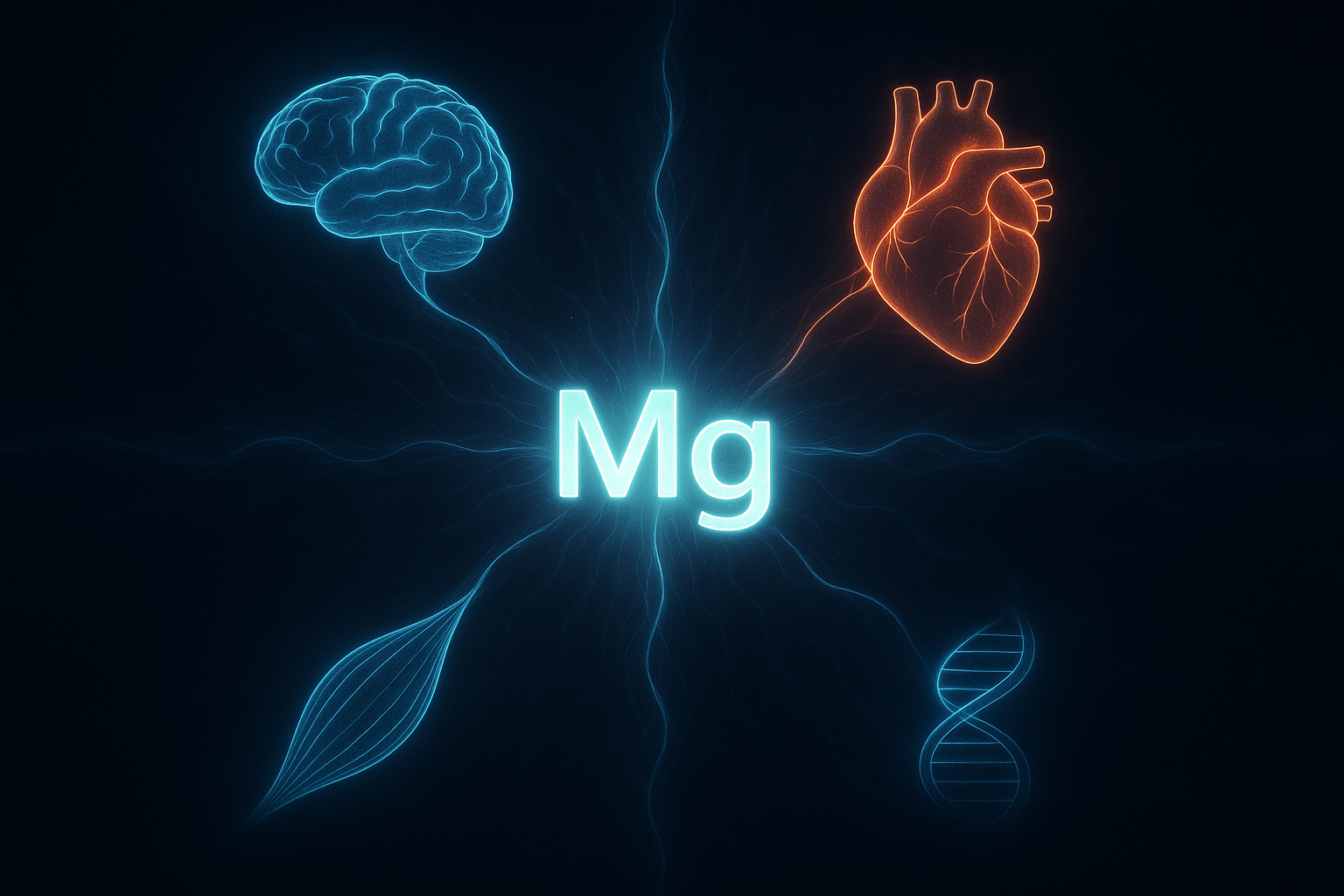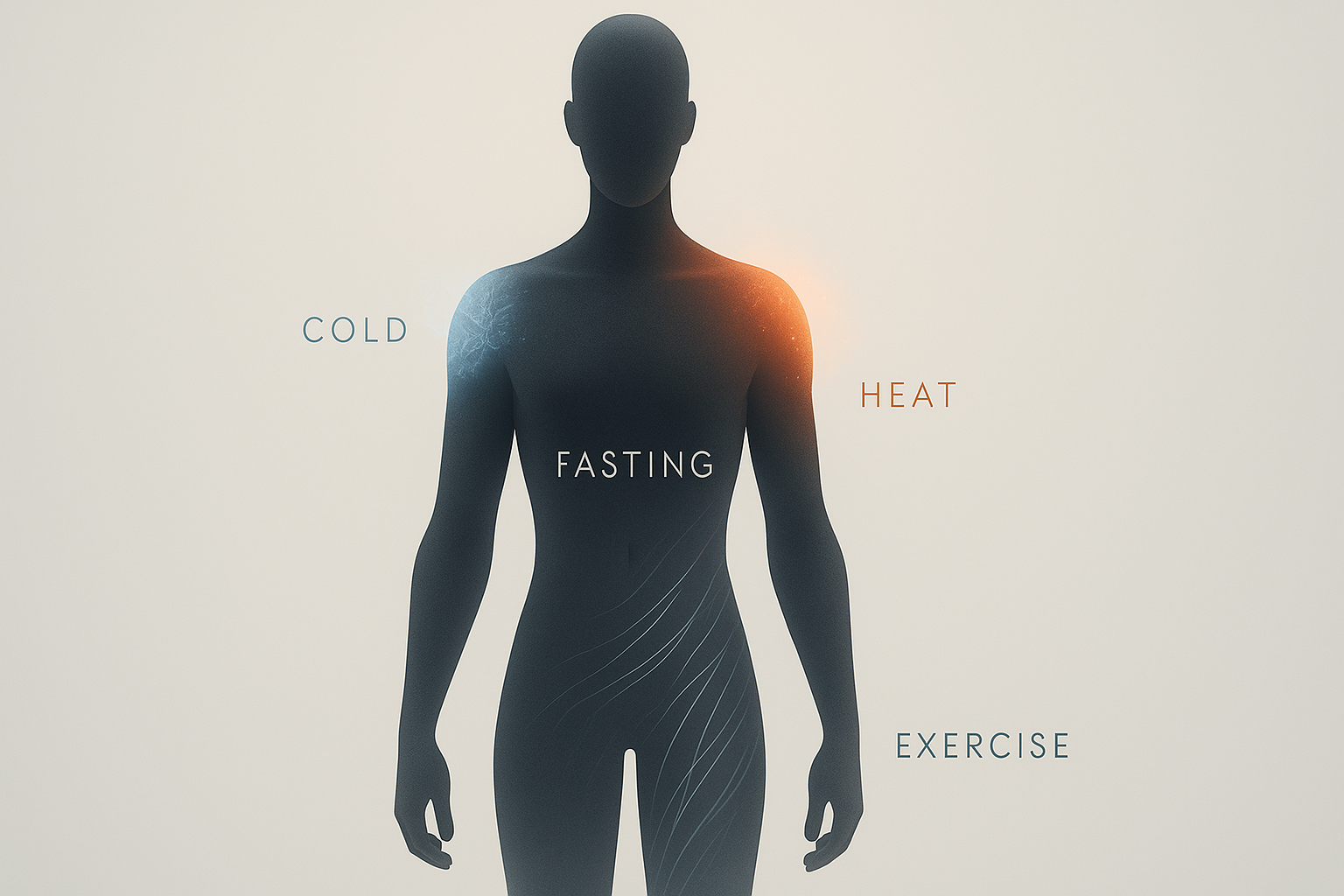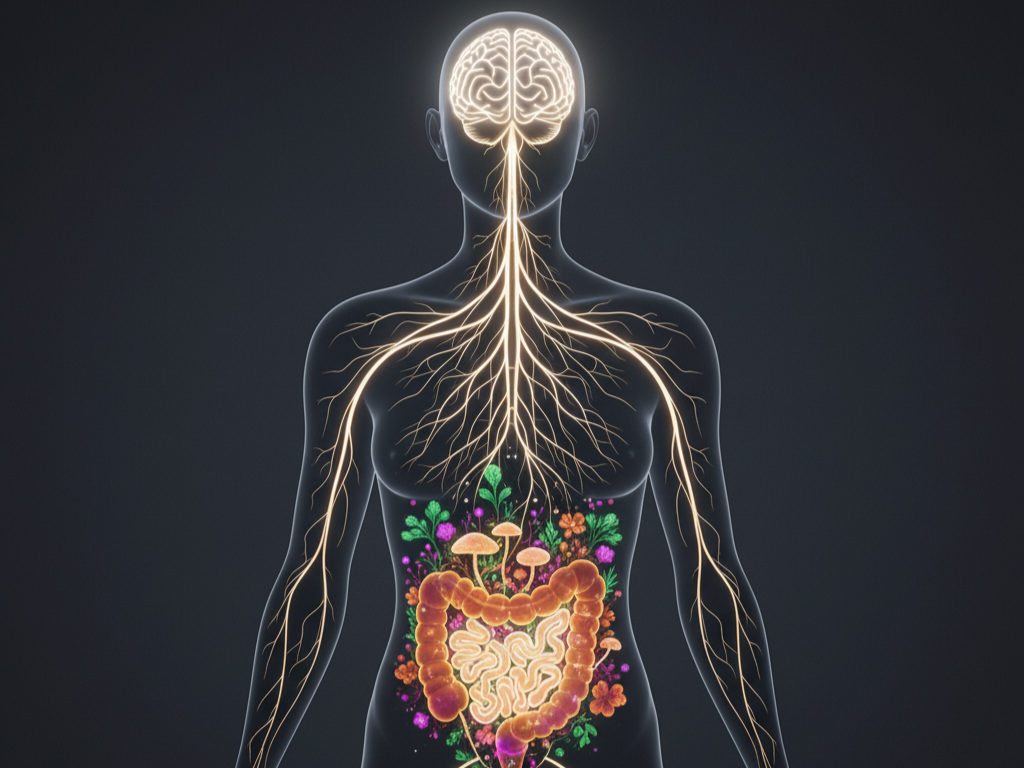Listen to the article as a podcast (beta)
KEY TAKEAWAYS
- The Element of Life: Magnesium is a critical "co-factor" in over 300 biochemical reactions in your body, from producing cellular energy (ATP) to regulating your nervous system.
- Form Matters Most: The molecule attached to magnesium (the "chelate") determines its absorption and its primary benefit. Magnesium Oxide is poorly absorbed and should be avoided.
- Target Your Needs: Choose your magnesium based on your goal: Malate for energy, Bisglycinate for sleep and calm, Taurate for heart health, and L-Threonate for brain health.
- Smart Supplementation: Take magnesium with food to prevent digestive upset. Enhance its effects by pairing it with co-factors like Vitamin B6 and Vitamin D, but avoid taking it at the exact same time as high-dose zinc or calcium supplements.
- 1. Food First: The Best Dietary Sources of Magnesium
- 2. The Best and Worst Forms of Magnesium: A Clear Guide
- 3. How to Supplement Smarter: The Rules of Magnesium
- 4. What Depletes Your Magnesium Levels?
- 5. Can You Overdose on Magnesium?
- 6. Frequently asked questions (FAQs)
The effectiveness of a magnesium supplement depends on the molecule it's bound to (a process called chelation). This partner molecule determines how well it's absorbed and where it's most likely to be used in the body.
Feeling stressed, tired, or unable to switch off at night? Before you blame your busy schedule, the answer might lie in a single, crucial mineral: magnesium. While it may not get the same attention as Vitamin D or Iron, magnesium is arguably one of the most important nutrients for modern life. So much so, that it’s often called the "element of life."
Why such a powerful title? Because magnesium is a key player—a "co-factor"—in over 600 essential biochemical reactions. It's vital for creating ATP (the energy currency of our cells), regulating our heartbeat, calming our nervous system, and even building our DNA. Without sufficient magnesium, your cellular batteries simply can't charge.
But here’s the problem: not all magnesium supplements are created equal. The bottle you grab from the shelf might be doing very little. The secret to unlocking its benefits lies in choosing the right form.
Food First: The Best Dietary Sources of Magnesium
Before considering supplements, the foundation should always be a nutrient-dense diet. While modern soil depletion can make it challenging to get enough magnesium from food alone, incorporating these powerhouses into your meals is a crucial first step:
- Leafy Greens: Spinach and Swiss chard are at the top of the list.
- Nuts and Seeds: Pumpkin seeds, almonds, and cashews are particularly rich.
- Fatty Fish: Salmon, mackerel, and halibut are excellent sources of both magnesium and omega-3 fatty acids.
- Avocados: A delicious source of magnesium, healthy fats, and fiber.
- Dark Chocolate: A great excuse to indulge—choose a variety with at least 70% cocoa.
- Legumes: Black beans, lentils, and chickpeas are excellent plant-based sources.
- Whole Grains: Quinoa and buckwheat are nutrient-dense, gluten-free options.
- Red Meat & Offal: Organ meats like liver are surprisingly dense sources of magnesium and other vital nutrients.
Focusing on these foods helps build your magnesium base, making supplementation more of a targeted strategy rather than a primary source.
The Best and Worst Forms of Magnesium: A Clear Guide
The effectiveness of a magnesium supplement depends on the molecule it's bound to (a process called chelation). This partner molecule determines how well it's absorbed and where it's most likely to be used in the body. Before we dive into the specific types, it's crucial to understand how to read the labels correctly.
A Crucial Note on Dosage: Elemental vs. Total Magnesium
When you look at a supplement bottle, you'll often see a large number, like "1000 mg." This usually refers to the total weight of the entire magnesium compound (e.g., 1000 mg of Magnesium Malate). However, the amount that truly matters is the elemental magnesium—the actual amount of pure magnesium available for your body to use. For instance, 1000 mg of Magnesium Malate provides only about 150 mg of elemental magnesium.
The Recommended Daily Allowance (RDA) for magnesium is around 300-400 mg. However, this includes magnesium from all sources. Since you get a significant amount from food (like nuts, seeds, and leafy greens), a good supplementation strategy is to aim for about 60% of the RDA, which is roughly 180-250 mg of elemental magnesium per day. This prevents over-supplementation, especially if you are combining different forms, e.g., Malate in the morning and Bisglycinate in the evening.
The A-Team: Highly Bioavailable Forms
Magnesium Malate (for Energy & Muscles)
- What it is: Magnesium bound to malic acid, a natural compound essential for creating ATP.
- Primary Benefits: Excellent for boosting energy levels, combating fatigue, and soothing muscle soreness. It's the "energy" magnesium.
- Best For: Athletes, individuals with chronic fatigue, or those experiencing muscle pain.
- When to Take: In the morning or early afternoon with a meal.
- Typical Dosage: Aim for a dose providing 60-80% of the daily allowance of elemental magnesium (approx. 200-300 mg). This roughly corresponds to 1300-2000 mg of Magnesium Malate.
Magnesium Taurate (for Heart & Blood Sugar)
- What it is: Magnesium bound to the amino acid taurine.
- Primary Benefits: This combination is particularly beneficial for cardiovascular health. It helps support healthy blood pressure, calms the nervous system, and may improve insulin sensitivity.
- Best For: Individuals focused on heart health and metabolic balance.
- When to Take: Can be taken in the morning or evening.
- Typical Dosage: Aim for a dose providing 60-80% of the daily allowance of elemental magnesium (approx. 200-300 mg). This roughly corresponds to 2200-3300 mg of Magnesium Taurate.
Magnesium Bisglycinate (for Calm & Sleep)
- What it is: Magnesium bound to two molecules of the amino acid glycine (hence "bis," meaning two). This is the fully chelated, superior form of magnesium glycinate.
- Primary Benefits: The ultimate form for reducing anxiety, calming the nervous system, and significantly improving sleep quality. It is highly bioavailable and exceptionally gentle on the stomach.
- Best For: Anyone struggling with stress, anxiety, insomnia, or muscle cramps at night.
- When to Take: In the evening, about an hour before bed.
- Typical Dosage: Aim for a dose providing 60-80% of the daily allowance of elemental magnesium (approx. 200-300 mg). This roughly corresponds to 1400-2100 mg of Magnesium Bisglycinate.
Magnesium L-Threonate (for Brain Health)
- What it is: A unique form of magnesium that has been shown to effectively cross the blood-brain barrier.
- Primary Benefits: Specifically enhances cognitive function, improves memory and learning, and may protect against age-related cognitive decline.
- Best For: Students, professionals, and anyone looking to support long-term brain health.
- When to Take: Can be taken in the morning or early afternoon.
- Typical Dosage: Follow product-specific recommendations, which typically provide around 144 mg of elemental magnesium per day from a 2000 mg dose of Magtein® (Magnesium L-Threonate).
The "So-So" Form: Good, But With a Caveat
Magnesium Citrate
- What it is: Magnesium bound to citric acid. It has good bioavailability (better than Oxide).
- The Caveat: While it's well-absorbed, it has a strong osmotic effect, drawing water into the intestines. This makes it a very effective laxative, which can be a significant side effect for those who don't need it.
- Conclusion: A decent option if you also struggle with constipation, but Bisglycinate is a better choice for general supplementation without the digestive effects.
The Ones to Avoid: Low Bioavailability
Magnesium Oxide, Sulfate, Chloride, Hydroxide
- What they are: These are essentially magnesium salts. They are cheap and commonly used in low-quality supplements.
- The Problem: They have very poor bioavailability. Most of the magnesium is not absorbed and remains in the intestines, primarily acting as a laxative.
- Conclusion: Avoid these forms if you want to effectively raise your body's magnesium levels and reap its systemic benefits.
How to Supplement Smarter: The Rules of Magnesium
- Timing is Key: Take calming forms (Bisglycinate) at night and energizing forms (Malate) in the morning.
- Take With Food: While not strictly necessary for all forms, taking magnesium with a meal can prevent potential digestive upset.
- Synergistic Partners: Magnesium works best with its co-factors. Pair it with Vitamin B6 (which helps transport it into cells) and Vitamin D.
- What to Avoid: Do not take your magnesium at the exact same time as a high-dose zinc or calcium supplement, as they can compete for absorption. It's best to space them out by at least two hours.
What Depletes Your Magnesium Levels?
Even with a perfect diet and supplementation plan, certain lifestyle factors can actively drain your magnesium stores or inhibit its absorption. Be mindful of these "magnesium stealers":
- Chronic Stress: Your body uses magnesium to manage the stress response. High levels of cortisol cause your cells to release magnesium, which is then excreted through urine.
- Caffeine & Alcohol: Both act as diuretics, increasing the rate at which you lose magnesium and other essential minerals.
- High Sugar Intake: Processing sugar requires a significant amount of magnesium, depleting your reserves with every sugary snack or drink.
- Phytic Acid in Unprepared Nuts & Grains: Here's a key nuance. While foods like nuts and seeds are rich in magnesium, in their raw state they also contain phytic acid. This "anti-nutrient" can bind to magnesium in the gut and block its absorption. The solution isn't to avoid these healthy foods, but to prepare them properly. Soaking, sprouting, or roasting nuts and seeds can significantly reduce their phytic acid content, unlocking their full magnesium potential.
- Certain Medications: Diuretics, antacids, and some antibiotics can interfere with magnesium absorption or increase its excretion.
Can You Overdose on Magnesium?
Yes, it is possible to "over-magnesium" your system, especially with high doses from supplements. While your kidneys are good at filtering out excess, taking too much can overwhelm this process and lead to symptoms like diarrhea, nausea, and cramping. This is why sticking to a moderate supplemental dose (like the 60% RDA rule) is a wise approach to get the benefits without the side effects.
Should I look at the total dosage or the elemental magnesium on the label?
Always look for the "elemental magnesium" amount, usually found on the "Supplement Facts" panel. This is the actual amount of magnesium your body can use. The larger number on the front of the bottle is often the total weight of the magnesium compound.
What's the difference between Magnesium Glycinate and Bisglycinate?
Magnesium Bisglycinate is the superior, "fully chelated" form, meaning one magnesium ion is bound to two glycine molecules. This makes it more stable and better absorbed. "Magnesium Glycinate" can sometimes refer to a buffered form mixed with lower-quality magnesium oxide. Always look for "Bisglycinate" for the best quality.
Can I get enough magnesium from food?
While you can, modern farming has depleted magnesium in the soil. Rich sources include leafy greens, nuts, seeds, and dark chocolate, but many people still benefit from supplementation.
How long does it take to feel the effects?
Some benefits, like improved sleep from Magnesium Bisglycinate, can be felt within a few days. Correcting a deeper deficiency may take several weeks of consistent use.









